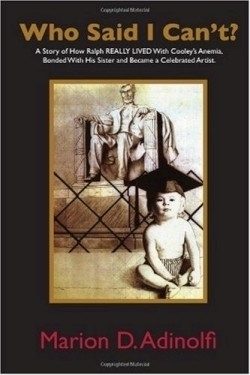Who Said I Can't?
A Story of How Ralph REALLY LIVED With Cooleys Anemia, Bonded With His Sister and Became a Celebrated Artist
If Cooley’s anemia were all Ralph Moscato had to face in his short life, it would have been more than enough hardship for a young man. But in addition to a fatal disease, he had a family that was a dysfunctional mess of codependency, guilt, blame, and violence that held Ralph and his two sisters in its loveless grip.
Who Said I Can’t? is a down-to-earth, tell-all memoir-a homespun tale written by Ralph’s oldest sister twenty-five years after his death at the age of thirty-two. It’s as much a tale of the author’s life as it is of her brother and his disease. Adinolfi built her life around her brother, who was born when she was ten; he essentially became her life when he was diagnosed with Cooley’s anemia as a toddler.
Cooley’s anemia, also known as Thalassemia, is a blood disease passed down through genes from both parents. Defective hemoglobin is unable to adequately transport oxygen, resulting in anemia and a host of debilitating symptoms. A sad irony is that the standard treatment in Ralph’s day was routine blood transfusions that eventually caused an iron overload that destroyed his organs.
Adinolfi wastes no words defending her parents, Italian immigrants who raised their family in the Bronx during the 1950s and ’60s. Her abusive, drunken father had connections to the Mafia, and her fragile, submissive mother alternated between anger and manipulation to keep her family in line. The family deteriorated as guilt and blame over a sick child overwhelmed a relationship that was fraught to begin with.
“They were both so stupid,” Adinolfi writes of her parents. “They knew Cooley’s anemia was a genetic disease, but they both dismissed Dr. Wolff’sÂ…explanation because it suited them. My parents were so wrapped up within themselves. We all suffered from their unhappiness.”
Adinolfi and Ralph hunkered together, she his protector and he her comforter; they forged a strong sibling bond, perhaps obsessively so, but one that under the circumstances was also their salvation.
Feisty and determined, Adinolfi, while raising a family of her own, managed to fill in for her parents to provide Ralph with a life that included education and an art career. He, in turn, provided her with the encouragement to get an education and become a teacher. While she intends the book as a tribute to Ralph—and it certainly is—it also speaks to the power of a sister’s love.
The book would have benefited from a careful edit; there are careless errors and some repetitious text. The dialogue, reconstructed decades later, is stiff and artificial. But this is a survivor’s tale. It isn’t perfect, and neither is life—as Adinolfi well knows.
Reading the book, it’s easy enough to imagine sitting down with Adinolfi and listening to the story of how she raised her brother to say, “Who Said I Can’t?” The power of love and determination are clear.
Disclosure: This article is not an endorsement, but a review. The publisher of this book provided free copies of the book and paid a small fee to have their book reviewed by a professional reviewer. Foreword Reviews and Clarion Reviews make no guarantee that the publisher will receive a positive review. Foreword Magazine, Inc. is disclosing this in accordance with the Federal Trade Commission’s 16 CFR, Part 255.

